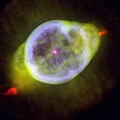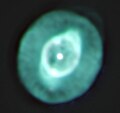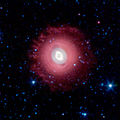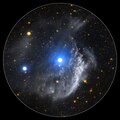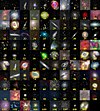Jupiter's spirit
|
Planetary Nebula NGC 3242 (Jupiter's Spirit) |
|
|---|---|
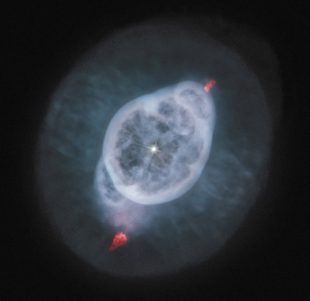
|
|
| False color display of an observation using the line filter of the Hubble space telescope : 658 nm (red), 656 nm (green) and 502 nm (blue). | |
| AladinLite | |
| Constellation | Water snake |
|
Position equinox : J2000.0 |
|
| Right ascension | 10h 24m 46s |
| declination | -18 ° 38 ′ 32 ″ |
| Appearance | |
| Apparent brightness (visual) | 7.7 likes |
| Apparent brightness (B-band) | 8.6 likes |
| Angular expansion | 20.8 ′ × 20.8 ′ |
| Central star | |
| designation | HD 90255 |
| Apparent brightness | 12.1 mag |
| Physical data | |
| Redshift | +0.000016 |
| Radial velocity | +4.7 km / s |
| distance | > 1400 ly |
| history | |
| discovery | William Herschel |
| Date of discovery | February 7, 1785 |
| Catalog names | |
| NGC 3242 • PK 261 + 32.1 • ESO 568-PN5 • GC 2102 • H IV 27 • h 3248 • CS = 12.0 | |
Jupiter's spirit (also known as NGC 3242 ) is a planetary nebula in the constellation Aquarius .
The nebula is made up of a denser area with a diameter of 16 × 24 arc seconds and a visibly weaker envelope with a diameter of 40 × 35 arc seconds. Since the outer shell of the nebula in the telescope is roughly the same size as the planet Jupiter , it is also referred to as the ghost of Jupiter. The apparent magnitude of the visible nebula is 7.7 mag.
However, photographic images show that the nebula is much more extensive at 20.8 arc minutes (for comparison: the moon has a diameter of around 30 arc minutes when viewed from Earth).
In the center there is a white dwarf star with an apparent magnitude of 12.1 mag. Its distance to the sun has not yet been clearly determined, but is usually given as 2,500 light years . Another estimate, however, assumes a distance of 1,400 light years.
The nebula was discovered on February 7, 1785 by William Herschel , who cataloged it as H IV 27. John Herschel observed it around 1830 from the Cape of Good Hope and included it in the General Catalog in 1864 as GC 2102 . In Dreyer's New General Catalog of 1888 it was given the number NGC 3242.
False color display to highlight the spatial distribution of various chemical elements ,
RGB image of the 81 cm mirror telescope of the Mount Lemmon Observatory
Mid-infrared image, Spitzer Space Telescope
UV recording with GALEX , a surrounding gas structure can be seen.
Web links
- Ghost of Jupiter, NGC 3242 High-resolution images from the 4m Mayall telescope
